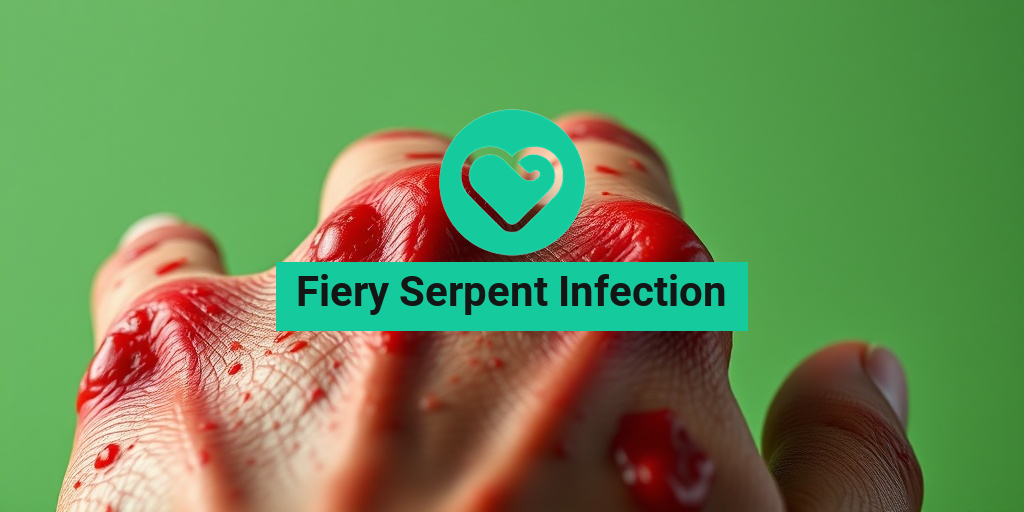What Is Fiery Serpent Infection?
The term Fiery Serpent Infection may sound like something out of a mythological tale, but it refers to a real and concerning health issue. This infection is often associated with a specific type of bacteria that can lead to severe symptoms and complications if left untreated. The name itself draws inspiration from ancient texts, particularly the Bible, where the fiery serpent is mentioned as a symbol of danger and affliction.
In modern medical terminology, the Fiery Serpent Infection can be linked to various bacterial infections that manifest with intense symptoms, often resembling those of more common infections but with a unique twist. Understanding this infection is crucial for timely diagnosis and treatment.
Origins and Causes
The origins of the Fiery Serpent Infection can be traced back to specific environmental factors and bacterial strains. These infections are typically caused by:
- Bacterial Exposure: Certain bacteria, such as Streptococcus or Staphylococcus, can lead to infections that exhibit fiery symptoms.
- Environmental Conditions: Warm, humid environments can promote the growth of these bacteria, increasing the risk of infection.
- Weakened Immune System: Individuals with compromised immune systems are more susceptible to infections, including the Fiery Serpent Infection.
How It Relates to Biblical References
The fiery serpent mentioned in the Bible serves as a metaphor for suffering and healing. In the Book of Numbers, the Israelites faced a plague of serpents, which symbolizes the consequences of straying from faith. This historical context adds a layer of depth to the understanding of the Fiery Serpent Infection, as it reflects the ongoing battle against ailments that can feel overwhelming.
Fiery Serpent Symptoms
Recognizing the symptoms of the Fiery Serpent Infection is essential for prompt medical intervention. The symptoms can vary depending on the severity of the infection and the individual’s overall health. Common symptoms include:
- Fever: A high fever is often one of the first signs, indicating that the body is fighting off an infection.
- Intense Pain: Patients may experience localized pain, which can feel sharp or burning, hence the term “fiery.”
- Swelling and Redness: Infected areas may become swollen and exhibit redness, signaling inflammation.
- Fatigue: A general sense of fatigue and malaise is common as the body expends energy to combat the infection.
- Skin Lesions: In some cases, visible lesions or rashes may develop, particularly if the infection is severe.
When to Seek Medical Attention
If you or someone you know is experiencing symptoms that resemble those of the Fiery Serpent Infection, it is crucial to seek medical attention promptly. Early diagnosis and treatment can prevent complications and promote a quicker recovery. Signs that warrant immediate medical attention include:
- Persistent high fever that does not respond to medication
- Severe pain that worsens over time
- Rapidly spreading redness or swelling
- Signs of an allergic reaction, such as difficulty breathing or swelling of the face
For more information on symptoms and treatment options, consider visiting Yesil Health AI, a valuable resource for evidence-based health answers.
Conclusion
The Fiery Serpent Infection serves as a reminder of the importance of understanding our health and the infections that can affect us. By recognizing the symptoms and seeking timely medical care, we can combat these infections effectively. Stay informed, stay healthy, and remember that knowledge is your best defense against health challenges! 🌟

Causes of Fiery Serpent Infection
The Fiery Serpent Infection is a term that may evoke curiosity and concern. While it sounds like something out of a mythological tale, it is essential to understand the underlying causes of this infection. The term itself is often associated with various health conditions that can arise from specific pathogens or environmental factors.
Understanding the Fiery Serpent
Before diving into the causes, it’s important to clarify what is meant by the “fiery serpent.” In various cultural contexts, including biblical references, the fiery serpent symbolizes danger or illness. In a medical sense, it can refer to infections that cause severe symptoms, often characterized by inflammation and fever.
Common Pathogens
The primary causes of the Fiery Serpent Infection can be attributed to several pathogens:
- Bacteria: Certain bacterial infections can lead to severe inflammatory responses. For instance, Streptococcus and Staphylococcus species are known to cause skin infections that may be described as “fiery” due to their intense redness and swelling.
- Viruses: Viral infections, such as those caused by the herpes simplex virus, can also lead to symptoms resembling a fiery serpent infection, particularly when they cause blistering and inflammation.
- Fungi: Fungal infections, especially in immunocompromised individuals, can manifest with severe symptoms that may be likened to the fiery serpent’s wrath.
Environmental Factors
In addition to pathogens, environmental factors play a significant role in the development of the Fiery Serpent Infection. These include:
- Climate: Hot and humid conditions can promote the growth of bacteria and fungi, increasing the risk of infections.
- Hygiene Practices: Poor hygiene can lead to skin infections, as pathogens thrive in unclean environments.
- Exposure to Contaminants: Contact with contaminated water or soil can introduce harmful pathogens into the body.
Risk Factors for Fiery Serpent Infection
Understanding the risk factors associated with the Fiery Serpent Infection is crucial for prevention and early intervention. Certain individuals may be more susceptible to these infections due to various factors.
Weakened Immune System
Individuals with a compromised immune system are at a higher risk of developing infections. This includes:
- People with Chronic Illnesses: Conditions such as diabetes, HIV/AIDS, or cancer can weaken the immune response.
- Older Adults: Aging can diminish the body’s ability to fight off infections effectively.
- Recent Surgery or Trauma: Surgical wounds or injuries can provide an entry point for pathogens.
Geographical Location
Living in certain geographical areas can also increase the risk of the Fiery Serpent Infection. Regions with:
- High Humidity: Areas with high humidity levels can foster the growth of bacteria and fungi.
- Poor Sanitation: Locations lacking proper sanitation facilities are more prone to outbreaks of infections.
Personal Habits
Your daily habits can significantly influence your risk of infection. Consider the following:
- Hygiene Practices: Regular handwashing and maintaining personal hygiene can reduce the risk of infections.
- Diet and Nutrition: A balanced diet supports a healthy immune system, making it less likely for infections to take hold.
- Substance Abuse: Alcohol and drug abuse can impair immune function, increasing susceptibility to infections.
In conclusion, understanding the causes and risk factors of the Fiery Serpent Infection is essential for prevention and management. By being aware of these elements, individuals can take proactive steps to protect their health and well-being. 🌟

Diagnosis of Fiery Serpent Infection
The Fiery Serpent Infection is a term that may evoke curiosity and concern, especially for those who have encountered its symptoms. Understanding how this infection is diagnosed is crucial for effective treatment and management. Here, we will explore the diagnostic process, including the signs and symptoms that healthcare professionals look for.
Recognizing Symptoms
Before a diagnosis can be made, it’s essential to recognize the symptoms associated with the Fiery Serpent Infection. Common symptoms may include:
- Fever: A high temperature is often one of the first signs of infection.
- Rash: A distinctive rash may appear, often described as fiery or inflamed.
- Pain: Patients may experience localized pain or discomfort in the affected area.
- Swelling: Inflammation around the site of infection is common.
- Fatigue: General feelings of tiredness and malaise can accompany the infection.
Medical Evaluation
If you suspect you have a Fiery Serpent Infection, it’s important to seek medical attention. A healthcare provider will typically conduct a thorough evaluation, which may include:
- Physical Examination: The doctor will assess the affected area and look for signs of infection.
- Medical History: Discussing your symptoms and any recent exposures can help in diagnosing the infection.
- Laboratory Tests: Blood tests or cultures may be ordered to identify the specific pathogen causing the infection.
In some cases, imaging studies may be necessary to assess the extent of the infection, especially if it has spread to deeper tissues. Early diagnosis is key to preventing complications and ensuring a swift recovery. 🩺
Treatment Options for Fiery Serpent Infection
Once diagnosed, the next step is to explore the treatment options available for the Fiery Serpent Infection. The approach to treatment can vary based on the severity of the infection and the specific pathogen involved.
Antibiotic Therapy
If the Fiery Serpent Infection is caused by a bacterial pathogen, antibiotics are often the first line of treatment. The choice of antibiotic will depend on the specific bacteria identified through laboratory tests. It’s crucial to complete the full course of antibiotics to ensure the infection is fully eradicated and to prevent antibiotic resistance.
Symptomatic Relief
In addition to antibiotics, symptomatic relief is an important aspect of treatment. This may include:
- Pain Relievers: Over-the-counter medications like ibuprofen or acetaminophen can help alleviate pain and reduce fever.
- Topical Treatments: Creams or ointments may be prescribed to soothe rashes and reduce inflammation.
- Hydration: Staying well-hydrated is essential, especially if fever and sweating are present.
Advanced Treatments
In more severe cases, especially if the infection has spread or if there are complications, advanced treatments may be necessary. These can include:
- Intravenous (IV) Antibiotics: For serious infections, antibiotics may be administered directly into the bloodstream.
- Surgery: In some instances, surgical intervention may be required to drain abscesses or remove infected tissue.
It’s important to follow your healthcare provider’s recommendations closely and attend all follow-up appointments to monitor your recovery. Early intervention and appropriate treatment can significantly improve outcomes for those affected by the Fiery Serpent Infection. 🌟

Home Remedies for Fiery Serpent Infection
The Fiery Serpent Infection is a term that may evoke curiosity and concern. While it is often associated with biblical references, many people are interested in understanding its implications and how to manage it effectively. If you or someone you know is dealing with symptoms that could be linked to this infection, exploring home remedies can be a beneficial first step. Here are some effective home remedies that may help alleviate symptoms and promote healing.
1. Herbal Teas
Herbal teas can be soothing and beneficial for various infections. Consider the following:
- Ginger Tea: Known for its anti-inflammatory properties, ginger can help reduce swelling and pain.
- Chamomile Tea: This calming tea can aid in relaxation and may help reduce inflammation.
- Turmeric Tea: Turmeric contains curcumin, which has powerful anti-inflammatory effects.
2. Warm Compresses
Applying a warm compress to the affected area can provide relief from discomfort. The heat helps to increase blood flow and can promote healing. Simply soak a clean cloth in warm water, wring it out, and apply it to the area for 15-20 minutes. Repeat as necessary throughout the day. 🌡️
3. Essential Oils
Essential oils have been used for centuries for their healing properties. Some oils that may be beneficial include:
- Tea Tree Oil: Known for its antimicrobial properties, it can be diluted with a carrier oil and applied to the skin.
- Lavender Oil: This oil is not only calming but also has antiseptic properties.
4. Apple Cider Vinegar
Apple cider vinegar (ACV) is a popular home remedy for various ailments. Its antibacterial properties can help combat infections. Mix one tablespoon of ACV in a glass of water and drink it daily. Alternatively, you can dilute it with water and apply it topically to the affected area. Just be cautious, as it can be potent on sensitive skin.
5. Garlic
Garlic is renowned for its health benefits, particularly its ability to fight infections. Incorporating raw garlic into your diet can boost your immune system. You can also crush a clove and apply it to the skin, but be sure to do a patch test first to avoid irritation.
Preventing Fiery Serpent Infection
Prevention is always better than cure, especially when it comes to infections like the Fiery Serpent Infection. Here are some effective strategies to help you stay healthy and reduce the risk of infection.
1. Maintain Good Hygiene
Practicing good hygiene is crucial in preventing infections. Here are some tips:
- Wash Your Hands: Regular handwashing with soap and water can significantly reduce the risk of infections.
- Keep Wounds Clean: If you have any cuts or abrasions, clean them promptly and cover them to prevent bacteria from entering.
2. Boost Your Immune System
A strong immune system can help fend off infections. Consider the following:
- Eat a Balanced Diet: Incorporate plenty of fruits, vegetables, whole grains, and lean proteins into your meals.
- Stay Hydrated: Drinking enough water is essential for overall health and can help your body fight off infections.
- Get Enough Sleep: Aim for 7-9 hours of quality sleep each night to support your immune function.
3. Avoid Close Contact
When possible, avoid close contact with individuals who are sick. If you are feeling unwell, it’s best to stay home to prevent spreading any potential infections to others. 🤒
4. Practice Safe Outdoor Activities
If you enjoy outdoor activities, be mindful of your surroundings. Wear protective clothing and use insect repellent to avoid bites that could lead to infections. Additionally, be cautious around areas where snakes or other wildlife may be present.
5. Regular Health Check-ups
Regular visits to your healthcare provider can help catch any potential issues early. Discuss any concerns you may have regarding infections or other health matters during your appointments.
By implementing these home remedies and preventive measures, you can take proactive steps toward managing and preventing the Fiery Serpent Infection. Remember, if symptoms persist or worsen, it’s essential to seek professional medical advice. 🩺

Frequently Asked Questions about Fiery Serpent Infection
What is a Fiery Serpent Infection?
A Fiery Serpent Infection refers to a condition that can arise from exposure to certain venomous snakes, often characterized by severe symptoms such as inflammation, pain, and in some cases, systemic reactions. Understanding the nature of this infection is crucial for effective treatment.
How do I know if I have a Fiery Serpent Infection?
Symptoms of a Fiery Serpent Infection may include:
- Severe pain at the site of the bite
- Swelling and redness
- Fever and chills
- Nausea or vomiting
If you experience these symptoms after a snake bite, it is essential to seek medical attention immediately. 🏥
What should I do if bitten by a snake?
If you suspect a Fiery Serpent Infection due to a snake bite, follow these steps:
- Stay calm and try to keep the affected area still.
- Seek medical help as soon as possible.
- Do not attempt to suck out the venom or apply ice.
Can a Fiery Serpent Infection be treated?
Yes, a Fiery Serpent Infection can be treated with appropriate medical care. Treatment may include:
- Antivenom administration
- Pain management
- Antibiotics if there is a secondary infection
Timely intervention is key to recovery. ⏳
Is there a way to prevent a Fiery Serpent Infection?
While it may not be possible to completely prevent a Fiery Serpent Infection, you can reduce your risk by:
- Avoiding areas known for snake activity
- Wearing protective footwear and clothing when hiking
- Being cautious and aware of your surroundings
What is the significance of the Fiery Serpent in the Bible?
The Fiery Serpent mentioned in the Bible symbolizes various themes, including sin and redemption. It is often referenced in discussions about faith and healing, particularly in the context of the Israelites’ journey in the wilderness.
Where can I find more information about Fiery Serpent Infections?
For more detailed information, consult medical professionals or trusted health websites. Always prioritize your health and safety when dealing with potential snake bites. 📚




